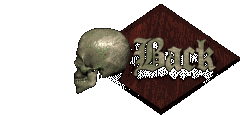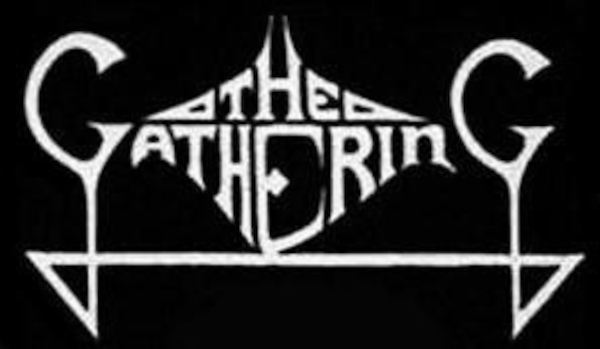



'Mandylion'

(Century Media Records 22. 08.1995
- reissue in 2005)
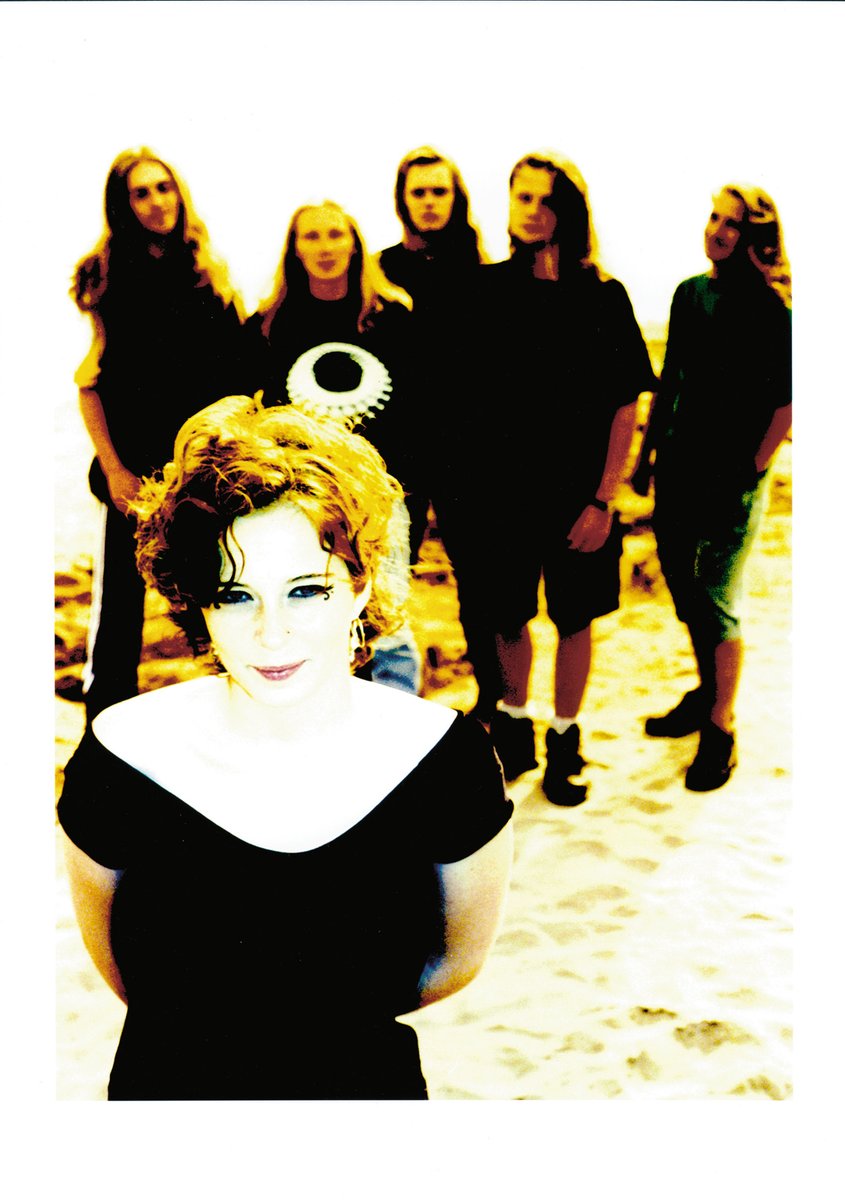
MARK: 95/100
Prologue
A little forgotten and belittled nowadays out of its homeland, The Gathering is still active today but almost nobody talks about its importance within the Metal world after being a small band that often pioneered and ventured into virgin territories; for instance it was one of the earliest to use keyboards in Gothic Metal and the second after Paradise Lost to adopt female backing vocals, but unluckily it was only able to release two neglectable albums at the beginning of its career. Still, in the mid-90s, the unit caught everyone's attention and touched very many people's souls with its blend of Gothic/Doom Metal, where Death growling was completely absent. Quite a risky call for a female fronted Metal band in 1995!
"Mandylion" was the first album with Anneke Van Giesbergen and all the stars must have been aligned with the Gathering's male members, who were able to grab the occasion at best after expelling the second-rate previous male and female singers to gamble on an unknown new vocalist with a heavenly blissful voice capable of taming Metal, that would additionally mix flawlessly with the depressive tunes they had just penned.
Mind, "Mandylion" was written not with Anneke's vocals in mind unlike the next releases with her.
Left behind the Death/Doom Metal of the first 2 albums, the musicians chose to pursue a sort of melodic Doom/Gothic Metal still keeping the experimentations deriving from the keys and synths which also appeared earlier.
The album, which came out just a few months after Theatre Of Tragedy's debut full-length, turned gold in the Netherlands in June 2024 after 29 years since its release, so we celebrate it with this review.
Package version
The version I bought is a double CD released by Century Media in 2005 in a lucid cardboard container on the 10th anniversary as a deluxe edition with a 16-page booklet.
Visual aspect
The cardboard container shows the same front and back cover that you find in the CD artwork: the background has golden textures, the band's logo is white with a refined elaborate G, a mix between italics and block letters. The Gathering has changed its logo 4 times in its career, but this is the first time I've seen such a logo, as the original front cover artwork saw a different logo, a differently coloured background (in red and black textures, while here they're golden and white-gold, with the white-gold almost invisible unless you watch it from a certain angle).
The 1995 logo was in lowercase block letters and it was white surrounded by golden edges, while the title of the album was in italics as if it had been written by someone as a signature. The 2005 title of the album uses a special font between italics and lowercase block letters.
On the front cover of the 2005 version a rectangle appears both on the cardboard and the booklet. Inside that is a magnified part of a Polynesian or maybe African tiki head containing a strange oval symbol in the mouth area. In the 2005 cover the head is perfectly central, while in the original issue it was a bit on the left. In both cases it reminds us of Dead Can Dance's first album cover artwork.
The tiki head usually demarcates a sacred territory, represents an idol or acts as a protective symbol.
The back cover displays the track list, record company info and issue date.
The second page of the booklet tells the events occurred in 1994 that brought to the platter's genesis and contains a white and black drawing in the background. There is an animal drawn in a comics style holding itself on a stick or crushing an insect while exhibiting a nasty smile.
In the third page we see the same strange symbol of the front cover again, and there is also a digital drawing portraying a person with thick hair, a scared face and a disproportionate smile.
The fourth includes a white background with the front cover textures repeated.
In the fifth the background is grey, the textures are the same and there appear black and white pictures of the musicians inside black frames.
The sixth recurs to the known textures on a black background, on which a naked human is lying. His face is somewhat deformed. There are also several Arabic writings and fish around him. All the subjects described are in golden yellow inside a crescent moon.
Page 7 contains a grey blackground on which a mythological bird within a black circle stands. Its wings remind me of simplified musical notes.
The mystery and the symbology thicken when we open the 8th and 9th page. Here the background is in the golden yellow that we already know so well, and the protagonist is a stylized astrological image of the sun.
The following page has a clear gray background and we notice some photos of the band inside more black frames.
The 11th page has a golden background and another symbol constituted by black and white curves reminding me of the 'G' in the logo, as well as band's notes, a thank list, a dedication and info on the production.
With the 12th page we get to know more about the second CD. The background has a gray background with the usual textures. Then there are 2 hallucinated eyes, a nose connected to a decorative seal, and writings in an unknown language. There is also a photo of the guitarist in the studio in a white frame.
Background and textures remain the same at page 13, but here we have a picture in black and white of the bassist in the studio in a white frame.
The background of the 14th page is golden gray, the frame is yellow gold, and the symbol is linked to the logo with its white, black and golden curves. We have a photo of the band and below their names and roles.
The next page has a black background with the already seen textures in a white frame, and a photo of the recording studio and Waldemar Sorychta, along with some comments by him.
The last page only has a golden background, some textures and the symbol connected to the band's logo in white spread partially there and partially on the front cover page.
All the booklet is based on drawings (some digital, some not, but all stylized) of pagan symbols, myths of the past or still used today in various cultures of the world, all connected to the tiki head at the front of the artwork.
The lyrics are all included with comments describing the creation of the compositions.
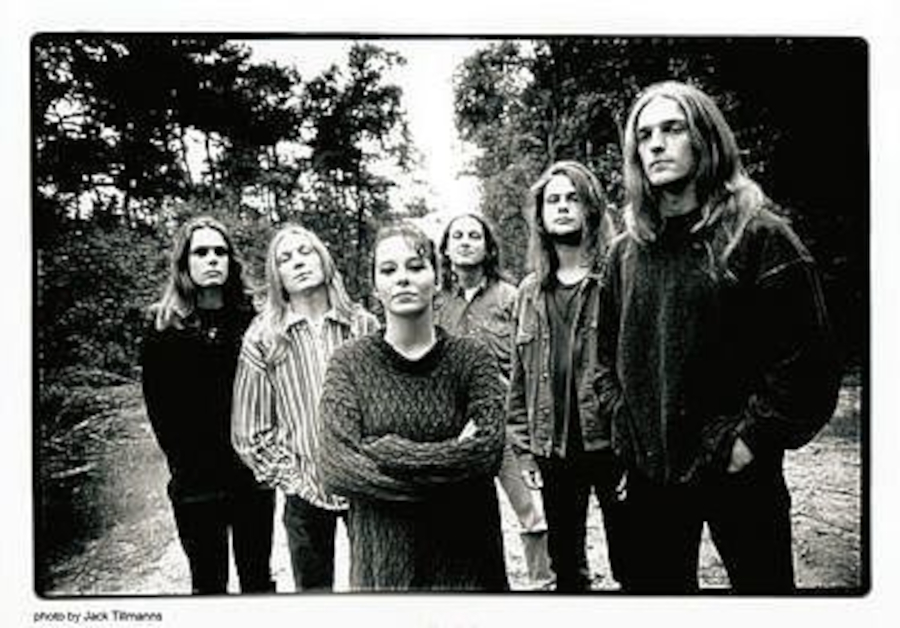
The
2 discs look yellow gold with the logo. The first has the title of the
album, the other the word 'demo' on it. Under the second CD is the
weird drawing of an anthropomorphic bird. In detail, this back
image of the CD tray displays a cave painting where this human-shaped
animal carefully keeps an egg (representing its offspring) between its
hands/claws. In other words The Gathering are trying to communicate
that their music aims to outlive its authors/parents.

(1995 original album cover)
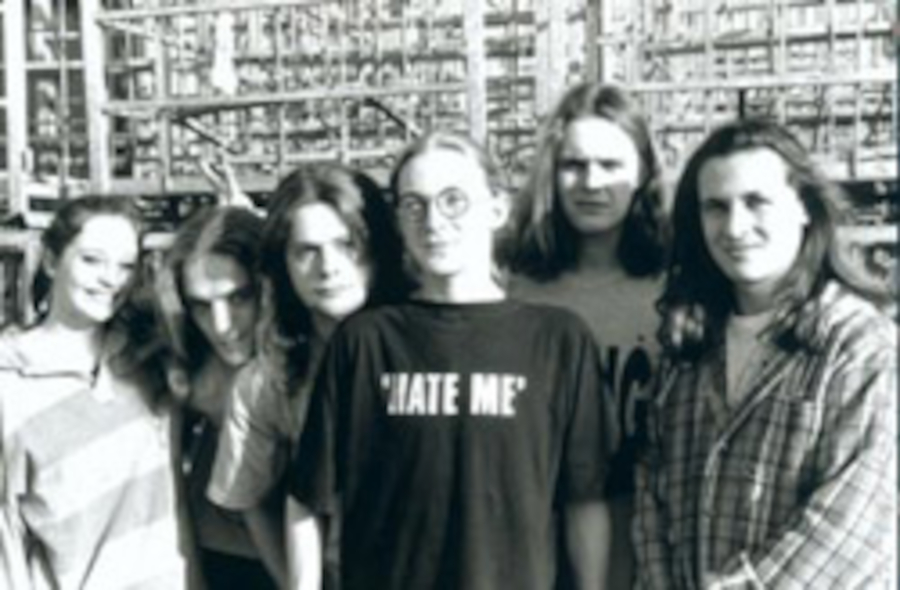
Trivia
Before recording "Mandylion" the band would rehearse above the carpentry of synthesizerist Frank Boeijen.
Despite the song title taken from "The Lord of the Rings", the lyrics of "Eleanor" were inspired by the movie "The Schindler's List".
Parts of the scenes of the official video for "Leaves" were shot in a forest in the southern Netherlands, others in the Vatican.
"Fear the Sea" was the last song written during the "Mandylion" sessions.
The title track was composed and performed live by Rene and Frank when they played in a project band named Diep Triest.
The Gathering recorded a soundtrack for the Belgian movie "The Lyricist", which ended up as a B-side on the "Rollercoaster" single, and another for a 2004 short Japanese flick titled "Tamago - The Quiet One".
Anneke has a soprano-type voice and a range of 7 octaves.
Nightwish's Floor Jansen said she was influenced by Anneke's singing style.
"Mandylion" is the only The Gathering's album with Anneke composed before her arrival, while the others with her were composed and tailored to serve her voice.
In 2005 the band provided music for a CD-Rom titled "Passengers in Time: The Musical History Tour". This CD accompanied a history study written by Professor Wim Kratsborn. However, the band do not see this as an official release. The CD features 11 exclusive tracks with a total duration of 46:30.
Lyrical content
All
the lyrics come from Anneke. They vary from desperation to dreams and are
respectively about:
* machines to travel in time.
* what lies under the mask of a selfish person identified by another person who is tired of their behaviour.
* cries, sobs and mental death.
* the end of a sentimental relationship.
* the fear of being swept away by a flood.
* the closeness of a person to a dear near death.
"Sand and Mercury" is a reference to time: the hourglass and clock.
* the longing for a beloved walking away and the tears cried while it's raining.
Engineering and sound quality
Recorded and mixed at Woodhouse studio in Hagen, Germany in June 1995 by Siggi Bemm and Waldemar Sorychta (who played in Despair, Eyes Of Eden, Enemy of the Sun, Grip Inc. and Voodoocult and worked at the production of Tiamat, Samael, Moonspell, Unleashed, Sentenced, Therion, Lacuna Coil, Alastis, Flowing Tears, Dismal Euphony, Rusty Eye, Sodom, Exhumer, Witchbreed, The Very End, Charm Designer, Tristania, The Other), the songs were mastered at DMS.
The sounds are as heavy as Black Sabbath, the production is crisp, and the vocals have not been mixed upfront.
Track-by-track musical analysis
The tracks belong in the realm of Atmospherical and Symphonic Doom/Gothic Metal, utilizing female vocals all the time except for rare male spoken words. Long instrumental parts occur in all compositions and this brought to a bold brief definition of Anathema and Dead Can Dance blended with occasional Dream Pop melodies.
The compositions are not afraid to dare with an exotic flute or even Medieval influences.
A bass player who does not mimic what the guitars are doing, and distorted melodic riffing which alternates between heavy chord guitar riffs and gorgeous stringed harmonies are a big help to the success of the songs. You can bet skill and difficulty in musical patterns are not the right words to portray them, but stellar creativity is definitely one that does.
The keyboards do not accompany, but fill and decorate, separated from the other instruments.
All tracks have their nuances and tempoes, except for "In Motion #1 and 2" which have a deliberate sober 6/8 beat.
CD nr. 1 contains 8 tracks and starts with "Strange Machines", a song matched by an official video ("https://www.youtube.com/watch?v=_e1pR3P3jaU") rich in hippie vibes, vintage effects and singer Anneke dancing all the time. The only official video currently available online is in low quality and it's a shame nobody has visually enhanced it in the years.
The song begins with a Doom Metal riff until drums and keyboards enter so as to stress out the majesty of the track. The entrance of the accompanying vocals and guitars, along with the minimalistic drum roll fills work like a charm. The then-new vocalist's shades intersect well during a fragment with euphonic beats and electronic noises preceding a fast Gothic Metal riff.
The keys come back in this lengthy instrumental section and later on so do the singing and the Doom Metal slice when the verse is repeated and in the chorus.
Then the synths dominate the scene while embellished by spoken words from George Pal's flick "The Time Machine" (even if the idea of the song comes from a novel of the same name by H.G. Wells) and crushing guitars. Next, synths in the background grow becoming cosmic space-like. Both the verse and the chorus appear again, there is a new break and another interval based on synths and electronic noises (mechanical breathing samples) while the drummer hits the splash cymbals for good. Finally, the number gets close to the end with a rapid instrumental chip seeing the synth producing long new sounds, that after a while fade out together with a guitar stroke.
In "Eleanor" it is dreamy keys from another dimension which have the task to open it anticipating pungent rocky drums and Doom Metal guitars. One more time the vocals set in and move us deeply. The rhythm accelerates a bit and then there is a short chunk in double bass.
We get back to the Doom Metal share that speeds up again until succinct double bass fills. The arrangement changes with an interlocutory instrumental tract before lively tom tom rolls, kick drums and dim keyboard touches.
It is now time for a headbanging Doom Metal riff matched with vocal parts, whereas in the next instants is an interruption by slow low-end drum rolls and a guitar riff chiselling a place for itself. After that, disquieting synths which gradually fade in with the drums till we reach a period with double bass and guitar acting as protagonists.
The next step consists in fairy keys going solo to draw a medieval landscape. Subsequently, the alternation between tight kick drums and keys reoccurs this time with the latter veering to medieval vibes again.
We meet the otherworldly refrain played multiple times in an obsessive way until the riff and the keybaords conclude the track fading out.
Joyful keys and groovy bass lines begin "In Motion #1" prior to the other instruments and finally Anneke's voice.
On more occasion the singer makes us daydream before the coming of the refrain consisting of 2 layers of vocals and the keys in the background to emprecious the melody. It is very likely the best refrain of the album.
An instrumental part with a keyboards solo ensues, then the verse is recovered and Anneke enchants us all with her angelic trained voice. And she goes on thus making us approach the highest corners of Heaven when our soul briefly detaches from our bodies.
The guitar makes a lick and a long solo perfect for the moment and genre. When the solo finishes there are relaxing synth sounds that go hand in hand with the emerging magical keyboards and the wonderful bass lines.
The refrain is back and the gleeful initial portion, too, diminishing gradually and slowing down in the finale with all the instruments.
This is a number that should be particularly appreciated by the British Shoe-gazer scene fans, especially of Slowdive and My Bloody Valentine, as well as by lovers of Dead Can Dance.
Coupled with an official video ("https://www.youtube.com/watch?v=ZKwOSZF4tts"), "Leaves" commences with a sweet reverberated arpeggio, a few keys interventions, and later on bass, drums and guitar licks arrive walking on tiptoe, as far as the song flares up by means of a slow riff and hypnotic vocals that make me fall in love. A Doom Metal instrumental cut endowed with an orchestral edge acts as a barrier from the following sung structure where Anneke uses all of her vocal extension both on the high and low register. After a while a concise and unhurried guitar solo (one of the rare ones present on this record) comes before an instrumental fraction containing guitar arpeggios and fluctuating keys that lead to a guitar lick and another Doom Metal pattern. After a long while, Anneke's reverberated vocals reappear, and they in turn make way to the nth instrumental passage that ends in a decrescendo between an arpeggio and a distorted guitar stroke that is faded out.
"Fear the Sea" enjoys powerful drumming, deep bass lines and a riff with a slightly Middle Eastern feel. The vocals make their appearance immediately, while the instrumentals are not long at all and are cut into small pieces. Some aggressive parts are sung, others are devoid of any singing.
Here is one of the finest riffs of the platter, and then a fairly fast part sung which is in turn replaced by a slower one where synths are placed on to remind us of whales' cries and next UFO's noises in a very Prog Metal allotment. During all this the guitar embroiders licks one better than the other.
After a few seconds we hear underwater noises accompanied by the bass and and drums until a break is delivered by a drum roll. The drums and guitar grow increasing the speed of the track, coupled with mid-range vocals. The aggressive riff returns, sustained by splash cymbal hits for 3 times until the riff closes the song all alone.
The Gathering have never been very Progressive, but if there is one song that may easily appeal to Pink Floyd's fans from the Dutch band, it can be this one.
An echoed Middle-Eastern-flavoured Shenhai flute going on a solo is what you find at the beginning of the title track, and soon afterwards synths from the reign of the dead are added.
The flute decreases its speed and makes a very long exhalation, superseded by tribal drums typical of world music, enriched by lively and appealing synths. Anneke sings without saying any word; she likes to play the siren for few instants before the synths become darker and the keys seem to describe the descent into a dungeon with sounds. An abrupt break on the trail of ancient Egypt with ritual drumwork and the same flute upfront together with a tambourine, windchimes and a semi-hidden synth bring the track to its demise.
The longest piece, "Sand & Mercury", skims 10 minutes and counts on an instrumental atmospherical inception made by an arpeggio, mid-paced drums and soft keys. After some piano lines a vigorous rhythmic section materializes together with a shy guitar. The rotation between mild and potent episodes goes on until the guitar neatly marks its official entrance and it is nice when it turns syncopated to duet with keys that seem to hail from an enchanted world.
Noteworthy is the Doom Metal riff that is played now, alternated with a palm-muted one over the omnipresent charming keys. Then there is silence for just one second and right away come cosmic synths that catapult us into a far-away galaxy. Things change again and now we listen to flowing water, while the guitar strokes are mixed low, and soon after loud when they squeal, nearing some brief cymbal whips that climax.
Anneke pops up and you can feel she decidedly feels what she's singing about. Her vocals are high, low, whispered, sometimes even expressed with pride and then prolonged, while the bass proceeds in a meandering manner and windchimes are used for just brief moments.
The vocals keep going all the time to emphasize the moment's gravity in a way that only Edgar Allan Poe would have equalled with the art of writing. Huge is the pathos of the composition so far, made even more beautiful by a Funeral Doom Metal riff which is more and more potent. Slowly, without any chance of stopping them, the drums and bass with the fundamental keyboards imitate a female paradisiac voice, and the guitar goes on a short solo.
All persists like this till the last guitar stroke and a reading by J.R.R. Tolkien quoting an article by existentialist philosopher Simone De Beavoir, which was the key to "Lord of the Rings". The reading is an excerpt from the TV show "In Their Own Words - British Authors" broadcast on BBC in 1968.
"In Motion #2" instantly reprises the first chapter through vocals and music on which a cello-led Goth soundscape is positioned on.
Then we are introduced to a moving bit where Anneke's vocals first are low, later high and finally she delivers the most potent ones of the full-length. That's how they became a model to imitate for Evanescence's Amy Lee 10 years after and for other colleagues of hers. These vocals are adorned by the presence of the guitar which reminds us of a river in flood when it is very distorted. On the contrary, when it contains itself, it leaves room for the cello.
The keys intensify to accentuate the circumstance, and I find the drum rolls precise and meaningful. The other keys lines perform with the guitars moving halfway between Doom Metal and Post-Grunge, when all of a sudden a refined guitar solo takes over, backed up by various inspiring keys and synths lines.
The vocals visit us again, as well as the cello in the most serious ration of this symphony, and before long the verse comes back for the last time, and the tune seethes quickly another time, repeating itself while it is being faded out.
The second CD contains 7 previously unreleased tracks that were comprised in two demos, one of June 1994, and the latter of early 1995.
It is inaugurated by the demo version of "In Motion #1", which has ensorcelled keys, sometimes more piano/orgen-like than on the album. The voice is nice Rock-oriented, but not as marvellous as on the final version. Besides these facts, the quality of the song is quite similar to the one obtained by Sorychta's.
The title track is less incisive and the keys sound somewhat trivial. This version appears a bit boring in general unfortunately because the keys and the tambourine don't mix properly and it just seems background music for a girl's cartoon or a documentary.
I can only spend positive words about the instrumental "Solar Glider", abundant in meaningful synths, fast-paced and recurring to triggered drums. It has massive riffs dominating half of the composition, some Power Metal, some in the vein of Black Sabbath, as heavily effected as the keys. A world of fairies unfolds before our eyes thanks to the keyboards used here. This song is stunning, but the group considered it too different to the rest to be included in the album track list.
Despite their opinion, I would have included in the track list as closing track, and also I wish The Gathering had recorded more music of this kind on their future releases.
And here are the tracks that derive from the second demo recorded at another studio.
"Eleanor" is the first track where I heard for the first time in my life a small imperfection in Anneke's performance in the studio. The keys might also enjoy better sounds on some occasions, but at the same time I like their cheeky edge at other brief moments. This version is devoid of the conclusive vocal lines that appeared on the album.
Within "In Motion #2" some cold spoken male backing vocals are held which make this rendition an alluring alternative, much more Gothic than the definitive version.
"Third Chance" sets up with guitar strokes and ethnic drums. Thereafter it grows into a fast rate song. It is indeed catchy and it surprisingly recycles the lyrics for "In Motion #1" because Anneke was not able to write lyrics that would fit the melodies.
It is founded on a simple bedrock and tailgating keyboard lines. There also blossom a lush guitar texture and mournful soloing keyboards passages, sustained by sluggish kickdrums and later cymbals. The tension increases, associated with spoken male vocals that may resemble the ones from an astronaut doing a live broadcast. The refrain reforms, catchy and reassuring, while the closure terminates brusquely. A song that puts The Breakfast Club, Garbage, Manic Street Preachers, Propaganda and Muse together in an organic manner.
Conclusively, "Fear the Sea" is faithful to the final translation that ended onto the platter, yet I deem it less involving, since it lacks dynamism and dexterity all along the atmospherical progressions.

Value
The
historical value of the original issue is higher, but if you are a
die-hard fan of the Netherlandian combo you need to have this version,
too, in order to have
a complete product around the "Mandylion" genesis.
Available versions
Besides the original vinyl and CD prints, and the following dozens of versions, this is the most complete version I have ever put my eyes onto and the one I prefer. As to the artwork you absolutely need to own a copy of the first pressing, so you can enjoy the much more elaborate original cover artwork, too.
Conclusion
The album that made Gothic/Doom Metal big is for sure one you can play for your friends who never or seldom listen to Metal.
Melancholic, ethereal, passionate, sombre, lush, bittersweet, mysterious, nocturnal, romantic, longing, poetic, introspective, epic, ponderous, poignant, otherworldly, haunting, mesmerizing, riveting, transcendent, and euphoric all at once with a vocalist who does not possess the operatic qualities of Tarja Turunen, and can therefore be described as a modern, more versatile version of All About Eve's Julianne Regan.
Anneke has other qualities: she can be a siren, a goddess, or a creature making wonders with her voice, caressing our innermost while our spirit is mesmerized. All of this on a full-length with musicians she had never worked with previously.
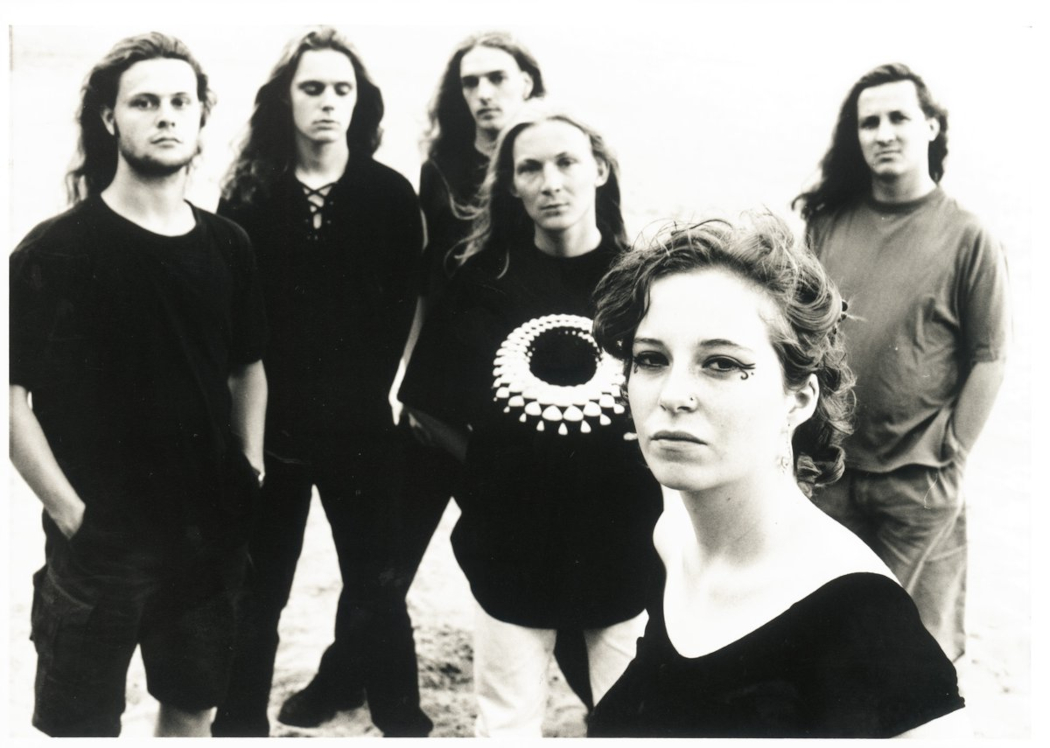
Tracklist:
1. Strange Machines
2. Eleanor
3. In Motion # 1
4. Leaves
5. Fear the Sea
6. Mandylion
7. Sand and Mercury
8. In Motion #2
Bonus tracks:
9. In Motion # 1
10. Mandylion
11. Solar Glider
12. Eleanor
13. In Motion # 2
14. Third Chance
15. Fear the Sea
Discography:
-An Imaginary Symphony (demo - 1990)
-Moonlight Archer (demo - 1991)
-Always... (full-length - 1992)
-Promo 92 (demo - 1992)
-Almost A Dance (full-length - 1993)
-Mandylion (full-length - 1995)
-Strange Machines (single - 1995)
-Adrenaline/Leaves (single - 1996)
-The May Song (single - 1997)
-Nighttime Birds (full-length - 1997)
-Out of the Dark - Live Compilation (split - 1997)
-Kevin's Telescope (single - 1997)
-How to Measure A Planet? (full-length - 1998)
-Liberty Bell (single - 1998)
-Diversity in Extremes (split - 1999)
-Shattering the Barriers (split - 2000)
-Superheat (live album - 2000)
-Rollercoaster (single - 2000)
-if_then_else (full-length - 2000)
-Amity (single - 2001)
-Downfall: The Early Years (compilation - 2001)
-Black Light District (EP - 2002)
-In Motion (video - 2002)
-Souvenirs (full-length - 2003)
-You Learn About It (single - 2003)
-Monsters (single - 2003)
-Teaser CD (split - 2004)
-Sleepy Buildings A Semi Acoustic Evening (live album - 2004)
-Accessories: Rarities & B-Sides (compilation - 2005)
-A Sound Relief (video - 2005)
-Alone (single - 2006)
-Home (full-length - 2006)
-Sziget Festival (split - 2006)
-A Noise Severe (live album - 2007)
-A Noise Severe (video - 2007)
-Sleepy Buildings - A Semi Acoustic Evening/Accessories: Rarities & B-Sides (boxed set - 2007)
-Sand and Mercury (boxed set - 2008)
-The West Pole (full-length - 2009)
-City from Above (EP - 2009)
-A Sound Relief (EP - 2010)
-Heroes for Ghosts (single - 2011)
-Meltdown (single - 2012)
-Disclosure (full-length - 2012)
-Afterlights (EP - 2012)
-Echoes Keep Growing (single - 2013)
-Afterwords (single - 2013)
-Afterwords (full-length - 2013)
-TG 25: Diving into the Unknown (boxed set - 2014)
-Original Album Collection (boxed set - 2015)
-Paper Waves (single - 2015)
-Strange Machines (single - 2015)
-King for A Day (single - 2015)
-TG 25: Live at Doornroosje (live album - 2015)
-Travel (single - 2015)
-In Motion (live album - 2016)
-Blueprints (compilation - 2017)
-A Sound Relief (live album - 2018)
-The Singles Collection (1995-2001) (boxed set - 2019)
-Collection Boxset (boxed set - 2020)
-In Colour (single - 2021)
-Stronger (Radio Edit) (single - 2021)
-We Rise (single edit) (single - 2022)
-Beautiful Distortion (full-length - 2022)
-Interference (EP - 2022)
-Stonegarden (30 Year Anniversary Version) (single - 2024)
Line-up on this album:
Anneke
Van Giersbergen - v. (also in Anneke Van Giersbergen, Vuur, ex-Devin
Townsend Project (live), ex-The Gentle Storm, ex-Moonspell (live),
ex-Agua de Annique, ex-Countermove, ex-Duo Bad Breath, ex-Seventh
Episode, ex-The Sirens)
Hans Rutten - d. (ex-Habitants)
Rene Rutten - g. (also in Habitants)
Jelmer Wiersma - g.
Hugo Prinsen Gerligs - b. (also in Magnum Machina, ex-Depeche Faux)
Frank Boeijen - k. (also in Zamora, ex-Depeche Faux)

Contacts:
Oss, North Brabant, Nijmegen, Gelderland - NL
E-mail:
Official website homepage:
http://www.gathering.nl/
Official main links:
Facebook
Myspace
Bandcamp
Instagram
DON'T MISS THIS ALBUM'S VIDEO REVIEWS IN ENGLISH AND
ITALIAN:
English video review:
https://youtu.be/Y9sDl_Fd0r0
Italian video review:
https://youtu.be/sVnNDL6L6Uw
